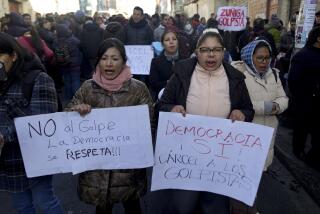Paz’s Year of Firm Democratic Leadership Halts Bolivia’s Slide Into Debt, Drugs
- Share via
LA PAZ, Bolivia — One year of firm political leadership by a strong, democratic president has halted Bolivia’s long slide into debt, drugs and national depression.
President Victor Paz Estenssoro, who completes the first year of his current administration Wednesday, has laid the basis for a national recovery.
This landlocked country, a kind of Afghanistan of South America, with a population largely of Indian peasants, is still in precarious economic health. But Paz has provided leadership for a comprehensive plan to repair years of damage.
Inflation has been halted. Foreign development aid is being restored. Some local investments are starting up. An attack has been mounted, with United States military aid, on big drug traffickers.
In Fourth Presidency
Paz, 78, now in his fourth presidency since 1952, has pursued his economic stabilization and recovery program relentlessly. He has disregarded short-run costs to his political party, the Nationalist Revolutionary Movement, and has used police against violence from left-wing opponents of his policies.
“Paz has taken on all the problems at once. The risks he is running are tremendous. He is getting away with it so far, but I don’t know how much longer he can do it without more outside help” said Antonio Sanchez de Lozada, the government’s general controller, a sort of official ombudsman.
When Paz took office last year, Bolivia was near collapse. A seven-year slide had brought this Andean country of 6 million people so low that it fell into the ranks of the world’s paupers.
From a relatively poor, but growing, country in the 1970s, Bolivia had become the South American equivalent of a sub-Saharan African economy. It owed $3.5 billion it could not pay. Printing press money covered 80% of government spending.
While cocaine traffickers got rich, most Bolivians became poorer. The World Bank estimates that the annual per capita income level dropped below $300 last year. It was $510 in 1983.
Domestic investment declined from a healthy annual rate of 21% of gross national product between 1973-78 to 9% a year from 1979 to 1983. As a result, production collapsed, while the population was growing by 2.6% a year.
The only economic areas that expanded were illegal--vast new plantations of coca leaf, covering at least 300,000 acres, and contraband imports that brought Scotch whisky, Japanese video equipment and even Rolls-Royce automobiles into this poor country.
Unemployment Critical
But this left most peasants dirt poor and created few urban jobs. The most explosive political problem Paz faces is unemployment, which has risen in the first stage of the recovery plan.
The government is Bolivia’s biggest employer. Strict controls on public spending have forced government offices, city halls and state enterprises to lay off about 7,000 workers.
Half of the 25,000 miners in the bankrupt state mining corporation, COMIBOL, are being laid off. This is making ghost towns out of mining communities that were once the mainstays of Bolivia’s economic life.
Workers threatened with layoffs have occupied their factories in Cochabamba, Bolivia’s second city, demanding protection against low-duty imports of shoes, clothing, and plastic goods.
Price stability has been welcomed by nearly everyone. Inflation had reached an annual rate 12,000% a year ago. The official consumer price index rose 3% between February and July.
Paz freed prices, raising gasoline 100%, and liberated imports. Prices have risen faster than wages, but marketplaces are filled with foodstuffs and buyers. Market vendors say that housewives are buying less, but there are no supply shortages as there were in the past.
“Paz has a lot of support from a silent majority that felt the country was disintegrating,” said Jorge Canelas, editor of Ultima Hora, an afternoon newspaper here.
But such middle-class support is not as militant as the opposition miners or factory workers. Among other important groups, such as city market women and peasants producing coca leaf, there is also resistance to other aspects of the Paz reforms.
Market women in their traditional black bowler hats have marched through the cobblestone streets of this colonial capital city in protest against a new sales tax.
Tens of thousands of peasants producing coca leaf for the cocaine economy fear the threat to their main cash crop. The U.S.-Bolivian drive is trying to destroy clandestine laboratories that buy coca paste from the peasants, and authorities Saturday reported the seizure of two more labs.
Bolivia’s economic planners seem to be uncertain and even fearful of the impact on the legal economy of disruption in cocaine activities.
The underground economy, based on illegal cocaine exports and vast contraband, is only partially visible in the national accounts kept by the Central Bank. But it is a financial reality that provides foreign exchange for necessary imports, as well as contraband.
For instance, before the U.S.-Bolivian anti-drug campaign began in July, Bolivian revenues from cocaine exports were estimated to bring in $600 million a year. Legal exports of minerals, oil and gas, and agricultural products this year are expected to earn less than $500 million.
But the tolerance and complicity of previous military dictatorships and weak civilian administrations in the drug traffic are widely seen to have led toward the destruction of the non-cocaine economy by inflation, corruption, contraband, and administrative breakdown.
These effects seem to have damaged Bolivia far more than it gained from the economic “benefits” that can be attributed to cocaine enrichment.
To meet all these problems, Paz said in an interview that a three-year economic recovery plan (to be announced Wednesday) has been drawn up. It proposes major changes in Bolivia’s economic structure and external economic relations, with increased foreign aid.
50-Year Loan
Bolivia received in July a $55-million loan, repayable in 50 years, from the World Bank as a first installment toward financing agricultural credit and industrial recovery.
Bigger projects are to be considered at an international lenders conference to be held in Paris in October under World Bank auspices. Paz said Bolivia hopes to attract public and private loans and investment of $500 million a year during the three-year plan.
The International Monetary Fund has backed Bolivia’s stabilization plan with a $50-million standby loan and is expected to provide another $70 million to compensate for the collapse of international tin prices.
The investment priorities will be oil and gas in the eastern lowlands of Santa Cruz province, from where Paz said he intends to built a $2-billion pipeline to Brazil. Gas exports to Argentina are now Bolivia’s main export, but the Brazilian market is much bigger.
Mining emphasis will be transferred from the highlands to new alluvial gold and tin mining areas in the Amazon provinces of Beni and Pando, on the northern border with Brazil.
More to Read
Sign up for Essential California
The most important California stories and recommendations in your inbox every morning.
You may occasionally receive promotional content from the Los Angeles Times.













